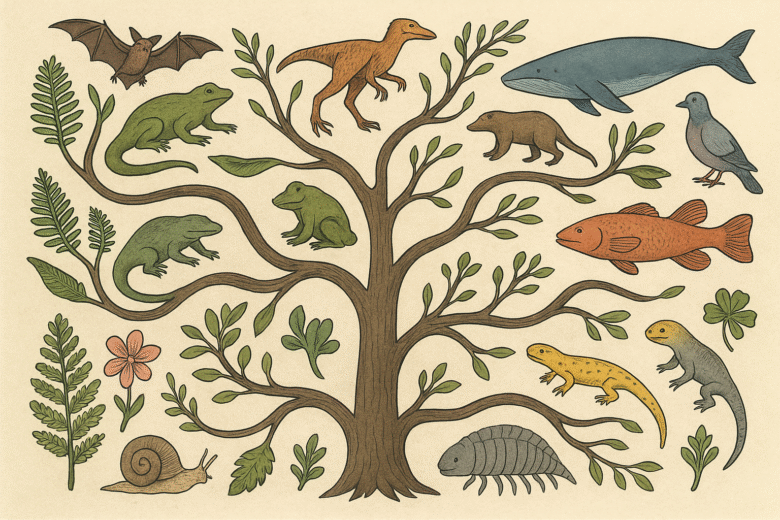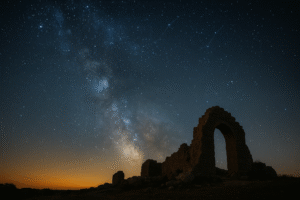Did you know that whales once walked on land with four sturdy legs? That’s right—the largest creatures in the ocean today were once furry, hoofed animals roaming ancient riverbanks. This fun fact isn’t just trivia; it’s a reminder of a bigger truth: evolution isn’t linear.
We often imagine evolution as a neat staircase—fish turn into amphibians, amphibians into reptiles, reptiles into mammals, and mammals into us. But the reality is far stranger. Evolution is less like a ladder and more like a tangled, messy banyan tree. Branches sprout, wither, reconnect, or vanish entirely. Life has taken countless detours, experiments, and dead ends along the way.
The story of evolution isn’t one of steady progress—it’s a chaotic journey filled with bizarre creatures, surprising comebacks, and paths that make us wonder: why did life zigzag instead of march straight ahead?
The Myth of the Evolutionary Ladder
The idea of a “ladder of progress” comes from outdated 19th-century thinking, where humans were seen as the pinnacle of evolution. But ask any biologist today, and they’ll tell you: evolution doesn’t have a direction or goal. It’s about survival, not perfection.
Cockroaches have been around for about 300 million years, barely changing their design while countless other creatures rose and fell. Meanwhile, entire dynasties of mighty dinosaurs came and went. Does that make roaches more “successful”? In a way, yes. They’ve mastered persistence, and that’s what evolution rewards.
Case Study 1: Whales That Walked
About 50 million years ago, the ancestors of whales—creatures like Pakicetus—looked more like wolves than dolphins. These land-dwelling mammals hunted along shorelines before slowly adapting to water. Over millions of years, their legs shrank, their nostrils slid back to form blowholes, and their bodies streamlined into the aquatic giants we know today.
But here’s the twist: some evolutionary branches of these proto-whales didn’t make it. They were experiments that ended in extinction. Whales are survivors of a very strange detour.
Case Study 2: Birds That Are Dinosaurs
Here’s a thought that still unsettles many: dinosaurs never really died out. They’re all around us, pecking at grains in your backyard or soaring above your head. Birds are not just similar to dinosaurs—they are living dinosaurs, descended directly from theropod species such as Velociraptor.
Evolution here didn’t move “forward” from reptile to bird. It branched. While most dinosaurs perished 66 million years ago in a fiery catastrophe, a feathered few made it through. They adapted into forms we see today—sparrows, pigeons, and eagles. Imagine that next time you see a chicken: you’re staring at the descendant of a T. rex.
Case Study 3: The Horses That Shrunk
When people think of horses, they imagine majestic stallions galloping across plains. Horses trace their roots back to Eohippus, a small, dog-sized ancestor that lived around 55 million years ago. For tens of millions of years, their size and shape fluctuated wildly. Some species grew huge, others remained small. At one point, horses in North America actually disappeared, only to be reintroduced thousands of years later by Spanish explorers.
Evolution here wasn’t a climb to a “perfect horse”—it was trial and error, shaped by shifting climates and landscapes.
Case Study 4: The Axolotl’s Refusal to Grow Up
The axolotl, a salamander found in Mexico, is a rebel in the evolutionary story. While most amphibians grow out of their gills and move to land, the axolotl stays forever young, keeping its juvenile features (like gills) throughout life. Scientists call this process “neoteny.”
It’s like evolution pressed the pause button. Instead of maturing like its relatives, the axolotl found a survival strategy in staying childish—and it works.
Case Study 5: The Strange Comeback of Coelacanths
For decades, scientists believed the coelacanth—a lobe-finned fish—had gone extinct 66 million years ago. In 1938, a supposed fossil from prehistory shocked the world when it was found alive—a coelacanth pulled from a South African fisherman’s net. Alive. Breathing. Moving.
Nicknamed a “living fossil,” the coelacanth proves evolution isn’t about leaving the past behind. Sometimes, ancient designs are so successful that they survive unchanged for eons.
The Dead Ends: Why Weirdness Matters
Not all evolutionary experiments lasted. From sabre-toothed cats to giant ground sloths and trilobites, countless species thrived for millions of years before disappearing forever. Were they “failures”? Not really. They were part of evolution’s trial-and-error process.
Every extinction and adaptation shaped the ecosystem for what came next. Without the extinction of the dinosaurs, mammals (and eventually humans) might never have had their chance.
Why This Matters to Us
Why should you care about strange evolutionary detours? Because they remind us that survival isn’t about being the strongest, smartest, or “most advanced.” It’s about being adaptable.
Humans like to believe we’re the final destination of evolution. But look at history—we’re just one branch among millions. One asteroid, one virus, or one climate shift could end our reign, just as it did for the dinosaurs. Evolution doesn’t guarantee our future.
If anything, the messy paths of life teach humility. We’re not the pinnacle—we’re temporary actors in a very long play. The script is still being written, and nature might decide to give the starring role to someone else.
Conclusion
Evolution isn’t linear—it’s experimental, messy, and full of surprises. Whales that once walked, dinosaurs that turned into pigeons, salamanders that refused to grow up, and fish that rose from extinction—all tell us the same story: life doesn’t march forward, it meanders.
And maybe that’s the point. Progress isn’t always about going in a straight line. Sometimes it’s about wandering, stumbling, and finding unexpected ways to survive.
So next time you look at a pigeon strutting on the street, a lizard basking in the sun, or even your own reflection in the mirror, remember: you’re looking at a survivor of a very strange and tangled journey.
Author’s Note
Writing about evolution always humbles me. We love to think of ourselves as the end product of a grand design, but the truth is more fascinating: we’re just one lucky branch of a vast evolutionary tree. If this blog made you rethink the way you see life’s journey, then it has done its job.
G.C., Ecosociosphere contributor.
References and Further Reading
- National Geographic – Evolution 101
- Smithsonian – Deep Time: Life’s Evolution




